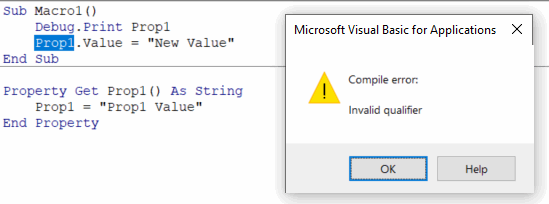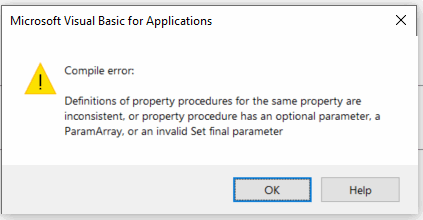Properties in Visual Basic
Properties have a very similar use to variables when it comes to consuming of the property
Set myObj = Property1 'assigning the reference value from the property to the variable myInt = Property2 ' assigning integer value from the property to variable Property3 = 0.1 'assigning double value to a property Set Property4 = CreateObject("ComClass") ' assigning the instance of COM class to property
The above code would look exactly the same if Property1, Property2, Property3 and Property4 were declared as variables and will have no difference in usage. The will also have the same intellisense icon

However properties declarations are more similar to functions.
Types Of Properties
There are 3 types of properties:
Read-Only Properties
Those properties can only return values. These properties act like functions:
Sub Macro1() Debug.Print Prop1 Debug.Print Prop2 Is Nothing 'Prop1.Value = "New Value" - not possible End Sub Property Get Prop1() As String Prop1 = "Prop1 Value" End Property Property Get Prop2() As Object Set Prop2 = CreateObject("Scripting.Dictionary") End Property
Attempt to assign the value to read-only property results in the invalid qualifier compile error

Write-Only Properties
The contrast to read-only properties are write-only properties which can be used to assign the value. These properties act like sub procedures.
Sub Macro2() Prop3 = "Val1" Set Prop4 = CreateObject("Scripting.Dictionary") End Sub Property Let Prop3(val As String) Debug.Print val End Property Property Set Prop4(val As Object) Debug.Print val Is Nothing End Property
There are Let and Set write properties. Let should be used to for simple types, such as String, Integer, Double, while Set properties should be used for reference types, such as Object or instances custom classes.
Note, it is still possible to use Let properties for reference types, in this case Set keyword is not required to assign the value to the property. This however is not recommended practice as this would make code less readable and misaligned with functions and variables where Set keyword always used with reference types.
Read-Write Properties
Read-write properties is a combination of read and write capabilities within a single property.
Sub Macro3() Prop5 = "Val1" Debug.Print Prop5 End Sub Property Get Prop5() As String Prop5 = "Prop5 Value" End Property Property Let Prop5(val As String) Debug.Print val End Property
Declaration of read and write properties must have the same name and have the same type, i.e. type of the parameter in the write property must match the type of the return value in read property, otherwise the Definitions of property procedures for the same property are inconsistent, or property procedure has an optional parameter, a ParamArray or invalid Set final parameter compile time error will be thrown
Property Get Prop1() As Integer Prop1 = Prop1 End Property Property Let Prop1(val As String) Debug.Print val End Property Property Get Prop2() Prop2 = "Prop2 Value" End Property Property Let Prop2(val As String) 'invalid as implicitly assigned type is Variant Debug.Print val End Property
Note that when type is not explicitly declared for the property it would be treated as Variant.
Properties With Parameters
Although this is rarely used, properties can have additional parameters.
Sub Macro4() Prop6("p1") = 20 Debug.Print Prop6("p2") End Sub Property Get Prop6(param1 As String) As Double Prop6 = 10 End Property Property Let Prop6(param1 As String, val As Double) Debug.Print param1 & " " & val End Property
If you need more than 1 parameter in the property, consider using function instead.
Usage
Although properties can be considered redundant as all the functionality covered by properties can be achieved by functions, properties provide better code readability and easier consumption of class or module. Prefer to use properties for the elements which describe the property of the entity rather than action, for example for the class Car, it would be beneficial to declare Color, Made, YearOfManufacturing as properties (instead of GetColor, SetColor, GetMade etc. functions), while Drive would be declared as procedure.
